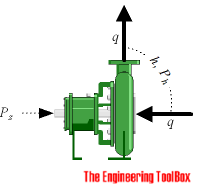Hydraulic Pump Power
The ideal hydraulic power to drive a pump depends on
- the mass flow rate the
- liquid density
- the differential height

- either it is the static lift from one height to an other or the total head loss component of the system - and can be calculated like
Ph(kW) = q ρ g h / (3.6 106)= q p / (3.6 106) (1)wherePh(kW) = hydraulic power (kW)q = flow (m3/h)ρ = density of fluid (kg/m3)g = acceleration of gravity (9.81 m/s2)h = differential head (m)p = differeential pressure (N/m2, Pa)
The hydraulic Horse Power can be calculated as:
Ph(hp) = Ph(kW) / 0.746 (2)wherePh(hp) = hydraulic horsepower (hp)
Or - alternatively
Ph(hp) = qgpm hft SG / (3960 η) (2b)whereqgpm = flow (gpm)hft = differential head (ft)SG = Specific Gravity (1 for water)η = pump efficiency
Example - Power pumping Water
1 m3/h of water is pumped a head of 10 m. The theoretical pump power can be calculated as
Ph(kW) = (1 m3/h) (1000 kg/m3) (9.81 m/s2) (10 m) / (3.6 106)
= 0.027 kW
Shaft Pump Power
The shaft power - the power required transferred from the motor to the shaft of the pump - depends on the efficiency of the pump and can be calculated as
Ps(kW) = Ph(kW) / η (3)wherePs(kW) = shaft power (kW)η = pump efficiency